Treatment options for obesity have vastly expanded in the last decade, ranging from newer pharmacotherapy to less invasive endoscopic procedures for weight loss. Singapore General Hospital shares more about the bariatric endoscopic options.
OBESITY IN SINGAPORE
There is a steady increase in the number of patients living with obesity in Singapore.1 During the COVID-19 pandemic, nearly one-third of Singaporeans gained weight and are struggling to lose the excess weight.2
Patients with obesity are at high risk of developing complications, requiring intensive care unit (ICU) care, and mortality from COVID-19. Additionally, patients with obesity have a reduction in their life expectancy with increasing body weight.3,4
Despite such significant consequences, the idea of seeking medical attention for obesity is not well recognised, and patients often delay treatment.
The treatment options for obesity have vastly expanded in the last decade, ranging from newer pharmacotherapy to less invasive endoscopic procedures for weight loss.
WHAT ARE THE BARIATRIC ENDOSCOPIC OPTIONS?
The endoscopic options represent a minimally invasive non-surgical approach to induce weight loss in obesity. The options include:
- Intragastric balloons (IGB)
- Endoscopic sleeve gastroplasty (ESG) using the OverStitch device
- Primary obesity surgery endoluminal-2 (POSE-2)
All these procedures are either performed as a day surgery or short-stay procedure, depending on the patient profile.
WHO WOULD BENEFIT FROM BARIATRIC ENDOSCOPY?
Bariatric endoscopy procedures are suitable for:
- Patients with obesity (BMI > 27.5 kg/m2)
- Patients who do not qualify for bariatric surgery
- Patients who decline or are unsuitable for bariatric surgery
- Patients who are unsuccessful in achieving or maintaining weight loss after diet and lifestyle modifications alone
1. INTRAGASTRIC BALLOONS
IGB implantation is performed as an outpatient procedure for patients with obesity.5-6
Procedure process
The stomach is first inspected using an endoscope, and if there are no contraindications, an IGB is introduced into the stomach through the mouth. The balloon is expanded with fluid to the desired size (Figure 1).
The presence of a balloon within the stomach reduces the volume of food intake and suppresses the appetite. This, in combination with physical activity, would result in weight loss.
The balloon is left in the stomach for 12 months to assist in weight loss. At the end of 12 months, the intragastric balloon is removed by endoscopy.
Outcomes
The expected weight loss with an IGB is 11-15% at six months, and weight is maintained at one year.
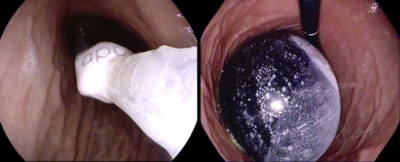
Figure 1 Intragastric balloons
Procedure time: 10-15 minutes (to insert and remove the balloon)
Hospitalisation: None – performed as an outpatient procedure
Adverse events: The rates of serious adverse events are low (1-3%). The frequent symptoms include nausea, vomiting and abdominal cramps, as the stomach has to adjust to the IGB. These symptoms will resolve within two weeks for approximately 90% of patients, and treatment is generally well-tolerated.
2. ENDOSCOPIC SLEEVE GASTROPLASTY
ESG is a non-surgical gastric volume reducing procedure for weight loss.7
Procedure process
It is performed using an endoscope fitted with a suturing device (OverStitch, Apollo Endosurgery, USA) at the tip. The suturing device is introduced through the mouth while the patient is under general anaesthesia.
Using specialised sutures and accessories, the doctor performs full-thickness stitches in the body of the stomach to make it smaller, like a tube. By restricting the stomach size, the distensibility is controlled and the meal volume is reduced (Figures 2 and 3).
Outcomes
ESG leads to significant weight loss because of its ability to slow the emptying of the stomach and cause early satiety, leading to quick meal termination.
Commitment to a healthy lifestyle is crucial for the long-term success of any weight loss procedure. ESG, when offered within multidisciplinary support, results in about 15-20% of total body weight loss at 12 to 24 months.
The procedure can be reversed when required and can also be repeated in the future, depending on the need.
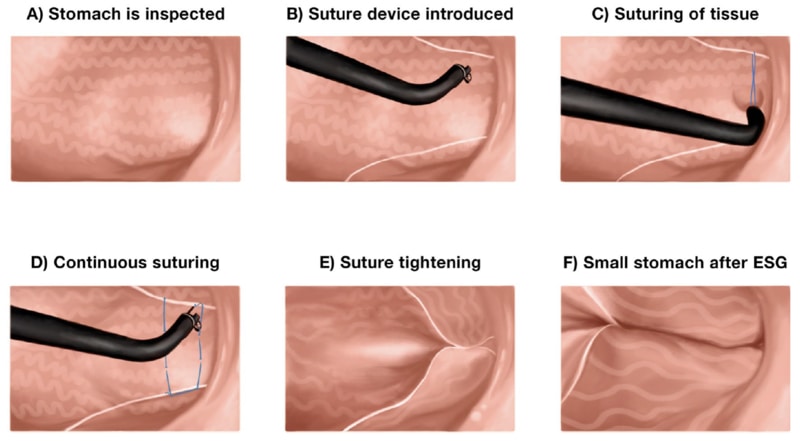
Figure 2 Endoscopic sleeve gastroplasty process
© Apollo Endosurgery, USA
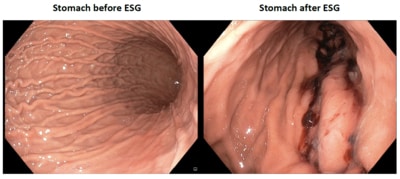
Figure 3 Endoscopic sleeve gastroplasty: before and after
Procedure time: 45-60 minutes
Hospitalisation: Short stay (24 hours)
Adverse events: ESG is minimally invasive and the risk of complications is low (1-2%). Patients can quickly return to their daily activities. Frequent symptoms include nausea, vomiting and abdominal cramps, which usually resolve within two days.
3. PRIMARY OBESITY SURGERY ENDOLUMINAL-2
POSE-2 is a non-surgical weight loss procedure aimed at shortening and narrowing the stomach in patients with obesity.8
Procedure process
It is performed using a specialised device (Transport, USGI Medical, USA), which places multiple sutures in the body of the stomach (Figure 4 and 5).
The POSE-2 device is advanced through the mouth into the stomach, and sutures are placed along the greater curve to reduce the stomach size by approximately 70%.
Unlike ESG, the suture plications in POSE-2 are discrete and interrupted. The multiple sturdy sutures of POSE-2 reduce gastric size and distensibility significantly, leading to appetite suppression and weight loss.
Outcomes
POSE-2, in combination with a healthy lifestyle, would result in a 15-20% weight loss at 12 months.
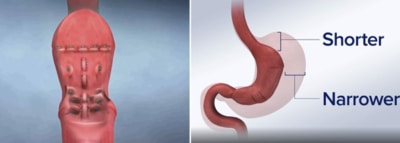
Figure 5 Primary obesity surgery endoluminal-2
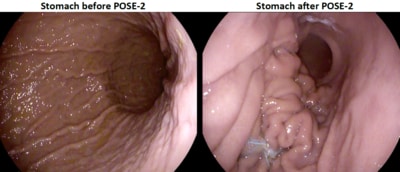
Figure 6 Primary obesity surgery endoluminal-2: before and after
Procedure time: 45-60 minutes
Hospitalisation: Short stay (24 hours)
Adverse Events: POSE-2 is minimally invasive and the risk of complications is low (1-2%). Frequent symptoms include nausea, vomiting and abdominal cramps, which usually resolve within two days with symptomatic treatment. Patients can return to their daily activities quickly.
WHAT ARE THE BENEFITS OF WEIGHT LOSS?
Bariatric endoscopic procedures are minimally invasive with an intent to induce weight loss. Adherence to a healthy lifestyle change and complying with the multidisciplinary follow-up instructions are key to achieving success.
By reaching the desired weight loss, patients lower their risk of obesity-related health problems like:9
- Type 2 diabetes mellitus
- Hypertension
- Heart disease and stroke
- Fatty liver disease
- High cholesterol
- Sleep apnoea
- Joint pain and osteoarthritis
Singapore General Hospital (SGH) is the first to offer these unique services to patients living with obesity. The experts delivering such care are well versed in endoscopic procedures and after-care. The bariatric endoscopy service is provided as integrated care together with the SGH Obesity Centre. To maximise the benefits of such procedures, it is crucial to function within a multidisciplinary unit. Pre- and post-procedure, the patients will be evaluated by dietitians, endocrinologists, psychologists and exercise therapists, depending on the patient profile. Patients need to be aware of and commit to regular follow-up appointments with the multidisciplinary team to assist in achieving the weight loss goals. We have observed an increased acceptance of bariatric endoscopic procedures among patients with obesity. The minimally invasive nature of the procedure, rapid recovery post-procedure, and resultant weight loss and comorbid illness improvement have encouraged many to seek such treatment. |
CONCLUSION
There is a large body of evidence supporting the safety and efficacy of bariatric endoscopic therapies for obesity. Their availability in Singapore has expanded the treatment armamentarium and options for patients. It is high time to raise awareness on bariatric endoscopy and provide patients with such possibilities, so they may benefit from these treatments.
REFERENCES
- https://www.moh.gov.sg/docs/librariesprovider5/default-documentlibrary/gbd_2017_singapore_reportce6bb0b3ad1a49c19ee6ebadc1273b18.pdf
- https://www.straitstimes.com/singapore/nearly-one-third-of-singaporeans-gain-weightduring-covid-19-pandemic-survey
- Khan SS, Ning H, Wilkins JT et al. Association of Body Mass Index With Lifetime Risk of Cardiovascular Disease and Compression of Morbidity. JAMA Cardiol. 2018 Apr 1; 3: 280287
- Bhaskaran K, Dos-Santos-Silva I, Leon DA et al. Association of BMI with overall and cause-specific mortality: a population-based cohort study of 3・6 million adults in the UK. Lancet Diabetes Endocrinol. 2018 Dec; 6: 944-953
- Lopez-Nava G, Asokkumar R, Rull A, Corbelle F, Beltran L, Bautista I. Bariatric endoscopy procedure type or follow-up: What predicted success at 1 year in 962 obese patients? Endosc Int Open. 2019 Dec;7(12):E1691-E1698. doi: 10.1055/a-1007-1769.
- Shah R, Davitkov P, Abu Dayyeh BK, Saumoy M, Murad MH. AGA Technical Review on Intragastric Balloons in the Management of Obesity. Gastroenterology. 2021 Apr;160(5):1811-1830. doi: 10.1053/j.gastro.2021.02.043.
- Lopez-Nava G, Laster J, Negi A, Fook-Chong S, Bautista-Castaño I, Asokkumar R. Endoscopic sleeve gastroplasty (ESG) for morbid obesity: how effective is it? Surg Endosc. 2021 Jan 25. doi: 10.1007/s00464-021-08289-1.
- Lopez Nava G, Asokkumar R, Laster J, Negi A, Normand E, Fook-Chong S, BautistaCastaño I. Primary obesity surgery endoluminal (POSE-2) procedure for treatment of obesity in clinical practice. Endoscopy. 2020 Nov 27. doi: 10.1055/a-1324-8498.
- Ryan DH, Yockey SR. Weight Loss and Improvement in Comorbidity: Differences at 5%, 10%, 15%, and Over. Curr Obes Rep. 2017;6(2):187-194. doi:10.1007/s13679-017-0262-y
Dr Ravishankar Asokkumar is a Consultant with the Department of Gastroenterology & Hepatology at Singapore General Hospital. He sub-specialises in bariatric and metabolic endoscopy and advanced therapeutic endoscopy. His expertise is in endoscopic gastroplasties and gastric volume reduction procedures.
He did his Advanced Endoscopy fellowship in Spain with Professor Gontrand Lopez-Nava, MD, Ph.D., a renowned pioneer and key opinion leader in bariatric endoscopy. Dr Ravishankar has extensive experience in endoscopic gastroplasties, intragastric balloons, endoscopic bariatric surgery revision procedures and novel therapies. He is active in clinical research and has published extensively on this topic. He has performed a large volume of endoscopic sleeve gastroplasties for obesity.
GPs who would like more information about this procedure, please contact Dr Ravishankar at ravishankar.asokkumar@singhealth.com.sg.
